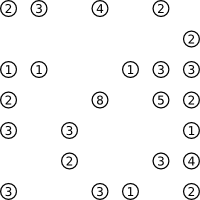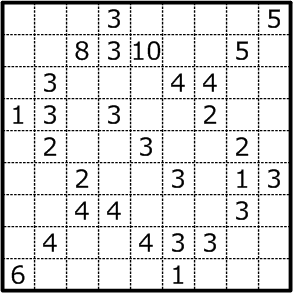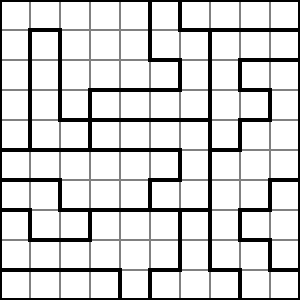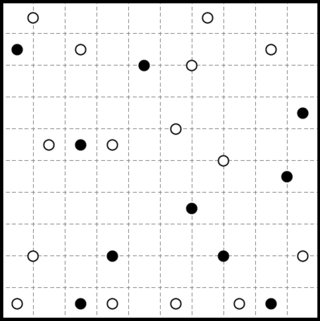
Stained Glass is a binary determination logic puzzle published by Nikoli.

Stained Glass is a binary determination logic puzzle published by Nikoli.
Stained Glass is played on a field of intersecting vertical, horizontal, and diagonal lines. At the intersections of some of these lines are small circles, either unshaded, grey shaded, or completely darkened.
The aim is to shade the correct shapes within the field such that all the circles correctly describe their neighboring areas.

White or black circles bordered by one or two shapes result in all bordering shapes being of the type specified by the circle. Once at least half of the bordering shapes on a grey circle are known to be of one type, the other half should also be known.

A crossword is a word puzzle that usually takes the form of a square or a rectangular grid of white- and black-shaded squares. The goal is to fill the white squares with letters, forming words or phrases that cross each other, by solving clues which lead to the answers. In languages that are written left-to-right, the answer words and phrases are placed in the grid from left to right ("across") and from top to bottom ("down"). The shaded squares are used to separate the words or phrases.

Nonograms, also known as Hanjie, Paint by Numbers, Picross, Griddlers, and Pic-a-Pix, and by various other names, are picture logic puzzles in which cells in a grid must be colored or left blank according to numbers at the side of the grid to reveal a hidden pixel art-like picture. In this puzzle type, the numbers are a form of discrete tomography that measures how many unbroken lines of filled-in squares there are in any given row or column. For example, a clue of "4 8 3" would mean there are sets of four, eight, and three filled squares, in that order, with at least one blank square between successive sets.

The shaded-pole motor is the original type of AC single-phase induction motor, dating back to at least as early as 1890. A shaded-pole motor is a small squirrel-cage motor in which the auxiliary winding is composed of a copper ring or bar surrounding a portion of each pole. When single phase AC supply is applied to the stator winding, due to shading provided to the poles, a rotating magnetic field is generated. This auxiliary single-turn winding is called a shading coil. Currents induced in this coil by the magnetic field create a second electrical phase by delaying the phase of magnetic flux change for that pole enough to provide a 2-phase rotating magnetic field. The direction of rotation is from the unshaded side to the shaded (ring) side of the pole. Since the phase angle between the shaded and unshaded sections is small, shaded-pole motors produce only a small starting torque relative to torque at full speed. Shaded-pole motors of the asymmetrical type shown are only reversible by disassembly and flipping over the stator, though some similar looking motors have small, switch-shortable auxiliary windings of thin wire instead of thick copper bars and can reverse electrically. Another method of electrical reversing involves four coils.

Tracery is an architectural device by which windows are divided into sections of various proportions by stone bars or ribs of moulding. Most commonly, it refers to the stonework elements that support the glass in a window. The purpose of the device is practical as well as decorative, because the increasingly large windows of Gothic buildings needed maximum support against the wind. The term probably derives from the tracing floors on which the complex patterns of windows were laid out in late Gothic architecture. Tracery can be found on the exterior of buildings as well as the interior.

Sudoku is a logic-based, combinatorial number-placement puzzle. In classic Sudoku, the objective is to fill a 9 × 9 grid with digits so that each column, each row, and each of the nine 3 × 3 subgrids that compose the grid contain all of the digits from 1 to 9. The puzzle setter provides a partially completed grid, which for a well-posed puzzle has a single solution.

Nurikabe is a binary determination puzzle named for Nurikabe, an invisible wall in Japanese folklore that blocks roads and delays foot travel. Nurikabe was apparently invented and named by Nikoli; other names for the puzzle include Cell Structure and Islands in the Stream.

Hitori is a type of logic puzzle published by Nikoli.

Hashiwokakero is a type of logic puzzle published by Nikoli. It has also been published in English under the name Bridges or Chopsticks. It has also appeared in The Times under the name Hashi. In France, Denmark, the Netherlands, and Belgium it is published under the name Ai-Ki-Ai.

Fillomino (フィルオミノ) is a type of logic puzzle published by many publishers. Other published titles for the puzzle include Allied Occupation.

LITS, formerly known as Nuruomino (ヌルオミノ), is a binary determination puzzle published by Nikoli.

Masyu is a type of logic puzzle designed and published by Nikoli. The purpose of its creation was to present a puzzle that uses no numbers or letters and yet retains depth and aesthetics.

Heyawake is a binary-determination logic puzzle published by Nikoli. As of 2013, five books consisting entirely of Heyawake puzzles have been published by Nikoli. It first appeared in Puzzle Communication Nikoli #39.

Slitherlink is a logic puzzle developed by publisher Nikoli.

Hotaru Beam is a binary-determination logic puzzle published by Nikoli.

Bag is a binary-determination logic puzzle published by Nikoli.

Gokigen Naname, also known as Slant, is a binary-determination logic puzzle published by Nikoli.
Keisuke is a logic puzzle published by Nikoli.
Yajisan-Kazusan is a binary determination logic puzzle published by Nikoli.

English Gothic stained glass windows were an important feature of English Gothic architecture, which appeared between the late 12th and late 16th centuries. They evolved from narrow windows filled with a mosaic of deeply-coloured pieces of glass into gigantic windows that filled entire walls, with a full range of colours and more naturalistic figures. In later windows, the figures were often coloured with silver stain, enamel paints and flashed glass. Later windows used large areas of white glass, or grisaille, to bring more light into the interiors.

Tentai Show, also known by the names Tentaisho, Galaxies, Spiral Galaxies, or Sym-a-Pix, is a binary-determination logic puzzle published by Nikoli.